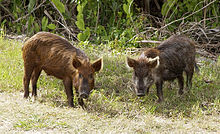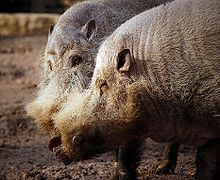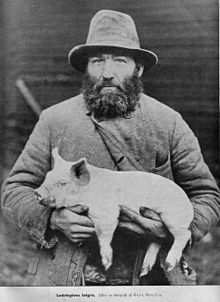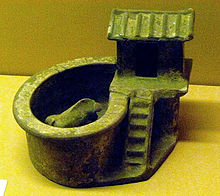
Pig
Did you know...
This Wikipedia selection is available offline from SOS Children for distribution in the developing world. A good way to help other children is by sponsoring a child
| Pig | |
|---|---|
 |
|
| A domestic sow and her piglet. | |
| Scientific classification | |
| Kingdom: | Animalia |
| Phylum: | Chordata |
| Class: | Mammalia |
| Subclass: | Theria |
| Infraclass: | Eutheria |
| Order: | Artiodactyla |
| Family: | Suidae |
| Subfamily: | Suinae |
| Genus: | Sus Linnaeus, 1758 |
| Species | |
|
|
A pig is any of the animals in the genus Sus, within the Suidae family of even-toed ungulates. Pigs include the domestic pig, its ancestor the wild boar, and several other wild relatives. Young and small pigs are known as piglets. Pigs are omnivores and are highly social and intelligent animals.
Description and behaviour
A typical pig has a large head with a long snout which is strengthened by a special prenasal bone and by a disk of cartilage at the tip. The snout is used to dig into the soil to find food and is a very acute sense organ. There are four hoofed toes on each trotter (foot), with the two larger central toes bearing most of the weight, but the outer two also being used in soft ground.
The dental formula of adult pigs is  , giving a total of 44 teeth. The rear teeth are adapted for crushing. In the male the canine teeth form tusks, which grow continuously and are sharpened by constantly being ground against each other.
, giving a total of 44 teeth. The rear teeth are adapted for crushing. In the male the canine teeth form tusks, which grow continuously and are sharpened by constantly being ground against each other.
Distribution and evolution
With around 1 billion individuals alive at any time, the domesticated pig is one of the most numerous large mammals on the planet.
The ancestor of the domesticated pig is the wild boar, which is one of the most numerous and widespread large mammals. Its many subspecies are native to all but the harshest climates of continental Eurasia and its islands and Africa as well, from Ireland and India to Japan and north to Siberia. Although it has been exterminated in some areas, its numbers are stable, or even increasing rapidly, in most of its native range.
Long isolated from other pigs on the many islands of Indonesia, Malaysia, and the Philippines, pigs have evolved into many different species, including wild boar, bearded pigs, and warty pigs. Humans have introduced pigs into Australia, North and South America, and numerous islands, either accidentally as escaped domestic pigs which have gone feral, or as wild boar. These have typically adapted well, and are increasing in number and broadening their range outside human control.
Habitat and reproduction
The wild pig (Sus scrofa) is able to take advantage of any forage resources. Therefore, it is able to live in virtually any productive habitat that can provide enough water to sustain large mammals such as pigs. If there is increased foraging of wild pigs in certain areas, it can cause a nutritional shortage which can cause the pig population to decrease. If the nutritional state returns to normal, the pig population will most likely rise due to the pigs' naturally increased reproduction rate.
Diet and foraging
Pigs are omnivores, which means that they consume both plants and animals. In the wild, they are foraging animals, primarily eating leaves, grasses, roots, fruits and flowers. In confinement pigs are fed mostly corn and soybean meal with a mixture of vitamins and minerals added to the diet.
Relationship with humans
Domesticated pigs are commonly raised as livestock by farmers for meat (generally called pork, hams, gammon or bacon), as well as for leather. Their bristly hairs are also used for brushes. Some breeds of pig, such as the Asian pot-bellied pig, are kept as pets.
Pigs that are allowed to forage may be watched by swineherds. Because of their foraging abilities and excellent sense of smell, they are used to find truffles in many European countries.
Both wild and feral pigs are commonly hunted.
Species
 |
Pig 'oink'
Oink!
|
| Problems listening to this file? See media help. | |
The genus Sus is currently considered to have 10 living species and a number of extinct species known as fossils:
- Sus ahoenobarbus Huet, 1888 - Palawan bearded pig
- † Sus australis Han, 1987 - Early Pleistocene of China
- Sus barbatus Müller, 1838 - Bearded pig
- † Sus bijiashanensis Han et al, 1975 - Early Pleistocene of China
- Sus bucculentus Heude, 1892 - Heude's Pig or Indo-Chinese (or Vietnam) warty pig
- Sus cebifrons Heude, 1888 - Visayan warty pig
- Sus celebensis Müller & Schlegel, 1843 - Celebes warty pig or Sulawesi warty pig
- † Sus falconeri - Pleistocene of the Siwalik region, India
- † Sus houi Qi et al, 1999 - Pleistocene of China
- † Sus hysudricus
- † Sus jiaoshanensis Zhao, 1980 - Early Pleistocene of China
- † Sus liuchengensis Han, 1987 - Early Pleistocene of China
- † Sus lydekkeri Zdansky, 1928 - Pleistocene of China
- † Sus offecinalis Koenigswald, 1933 - China
- Sus oliveri Groves, 1997 - Oliver's warty pig or Mindoro warty pig
- † Sus peii Han, 1987 - Early Pleistocene of China
- Sus philippensis Nehring, 1886 - Philippine warty pig
- Sus scrofa - Wild Boar Linnaeus, 1758
-
- Sus scrofa domestica Erxleben, 1777 - Domestic pig (sometimes treated as a full species)
- † Sus subtriquetra Xue, 1981
- † Sus strozzi
- Sus verrucosus Müller, 1840 - Java warty pig
- † Sus xiaozhu Han et al, 1975 - Early Pleistocene of China
The pygmy hog, formerly Sus salvanius is now placed in the monotypic genus Porcula.
Domestic pigs
Pigs have been domesticated since ancient times in the Old World. Archaeological evidence suggests that pigs were being managed in the wild in a way similar to the way they are managed by some modern New Guineans from wild boar as early as 13,000–12,700 BP in the Near East in the Tigris Basin. Remains of pigs have been dated to earlier than 11,400 BP in Cyprus that must have been introduced from the mainland which suggests domestication in the adjacent mainland by then. A separate domestication also occurred in China.
In India, pigs have been domesticated for a long time mostly in Goa and some rural areas for pig toilets. This was also done in China. Though ecologically logical as well as economical, pig toilets are waning in popularity as use of septic tanks and/or sewerage systems is increasing in rural areas.
Pigs were brought to southeastern North America from Europe by Hernando de Soto and other early Spanish explorers. Pigs are particularly valued in China and on certain oceanic islands, where their self-sufficiency allows them to be turned loose, although the practice is not without its drawbacks (see environmental impact). With managed rotational grazing techniques pigs can be raised in an environmentally sound manner on pasture much like grazing sheep, goats and cows without high grain inputs.
The domestic pig (Sus scrofa domesticus) is usually given the scientific name Sus scrofa, although some authors call it S. domesticus, reserving S. scrofa for the wild boar. It was domesticated approximately 5,000 to 7,000 years ago. Their coats are coarse and bristly. They are born brownish coloured and tend to turn more grayish coloured with age. The upper canines form sharp distinctive tusks that curve outward and upward. Compared to other artiodactyles, their head is relatively long, pointed, and free of warts. Their head and body length ranges from 0.9 to 1.8 m (35 to 71 in) and they can weigh between 50 and 350 kg (110 and 770 lb).
Pigs are intelligent and can be trained to perform numerous tasks and tricks. Recently, they have enjoyed a measure of popularity as house pets, particularly the dwarf breeds.
Environmental impacts
Domestic pigs that have escaped from farms or were allowed to forage in the wild, and in some cases wild boars which were introduced as prey for hunting, have given rise to large populations of feral pigs in North and South America, Australia, New Zealand, Hawaii, and other areas where pigs are not native. Accidental or deliberate releases of pigs into countries or environments where they are an alien species have caused extensive environmental change. Their omnivorous diet, aggressive behaviour, and their feeding method of rooting in the ground all combine to severely alter ecosystems unused to pigs. Pigs will even eat small animals and destroy nests of ground nesting birds. The Invasive Species Specialist Group lists feral pigs on the list of the world's 100 worst invasive species and says:

| “ | Feral pigs like other introduced mammals are major drivers of extinction and ecosystem change. They have been introduced into many parts of the world, and will damage crops and home gardens as well as potentially spreading disease. They uproot large areas of land, eliminating native vegetation and spreading weeds. This results in habitat alteration, a change in plant succession and composition and a decrease in native fauna dependent on the original habitat. | ” |
Health issues
Pigs can harbour a range of parasites and diseases that can be transmitted to humans. These include trichinosis, Taenia solium, cysticercosis, and brucellosis. Pigs are also known to host large concentrations of parasitic ascarid worms in their digestive tract. The presence of these diseases and parasites is one reason pork meat should always be well cooked or cured before eating. Today, trichinellosis infections from eating pork are relatively uncommon, at least in the United States, due to more stringent health laws, better refrigeration, and public awareness of the dangers of eating undercooked meat. Some religious groups that consider pork unclean refer to these issues as support for their views.
Pigs are susceptible to bronchitis and pneumonia. They have small lungs in relation to their body size; for this reason, bronchitis or pneumonia can kill a pig quickly. There is concern that pigs may allow animal viruses such as influenza or Ebola to infect humans more easily. Some strains of influenza are endemic in pigs (see swine influenza), and pigs also can acquire human influenza.
Pigs can be aggressive and pig-induced injuries are relatively common in areas where pigs are reared or where they form part of the wild or feral fauna.




